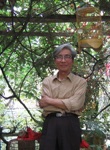Copyright © 1986-2016, Witness Collection and other copyright holders. All rights reserved.
Images and content on this site may not be reproduced in any form without prior written consent from Witness Collection.
For information about exhibitions, loans, internships or other forms of collaboration, please email us via the contact us page.

In 1968, during the Tết Offensive (Tết is Vietnamese lunar new year), Hiếu was based in Củ Chi, the area to the west of Saigon where communist forces ran their operations from a network of underground tunnels. He created many art works during this period, often under difficult or life-threatening conditions. In one of his simplest yet most impactful art works, US Bell Iroquois UH1D “Huey” helicopters fly overhead, on a search and destroy mission for North Vietnamese soldiers. Hiếu had to lie disguised in the long grass, while he sketched a quick portrayal of the helicopters, using just a few strokes of Chinese ink on paper. Although the sketch required speed and simplicity, it conveys the feeling of the moment by stripping it down to the bare essentials of Hiếu’s experience.
Hiếu was often secretly behind enemy lines and remains wary of sharing his full experiences from the wartime outside of his army circles. Prior to the end of the war in Saigon on 30 April 1975, Hiếu was already in the city and some of his sketches portray those last days of the war.
Hiếu first studied at the Vietnam Fine Art College from 1955-58. In 1977, he finally attended the full official course of Hanoi Fine Art University and graduated in 1982.
Trương Hiếu
